

Package with base classes for Buildings.HeatTransfer.Windows
This package contains base classes that are used to construct the models in Buildings.HeatTransfer.Windows.
Extends from Modelica.Icons.BasesPackage (Icon for packages containing base classes).
| Name | Description |
|---|---|
| Absorbed radiation by window | |
| Model for center of glass of a window construction | |
| Model for the heat transfer coefficient at the outside of the window | |
| Model for heat convection through gas in a window assembly | |
| Model for a glass layer of a window assembly | |
| Model for a interior (room-side) convective heat transfer with variable surface area | |
| Model for the heat transfer coefficient at the inside of the window | |
| For a window with an overhang, outputs the fraction of the area that is sun exposed | |
| Partial model for variables and data used in radiation calculation | |
| Partial model to implement overhang and side fins with weather bus connector | |
| Partial model for heat convection or radiation between a possibly shaded window that can be outside or inside the room | |
| Model for convective heat balance of a layer that may or may not have a shade | |
| Base class for models of window shade and overhangs | |
| Model for infrared radiative heat balance of a layer that may or may not have a shade | |
| Converts the shading signal to be strictly bigger than 0 and smaller than 1 | |
| For a window with side fins, outputs the fraction of the area that is sun exposed | |
| Block to interpolate between different window states | |
| Lumped thermal element with variable area, transporting heat without storing it | |
| Transmitted radiation through window | |
| Calculation radiation for window | |
| Free convection in horizontal cavity | |
| Free convection in vertical cavity | |
| Nusselt number for horizontal cavity, bottom surface warmer than top surface | |
| Nusselt number for horizontal cavity, bottom surface colder than top surface | |
| Get interpolated data without triggering events | |
| Basic parameters for window radiation calculation | |
| Radiation data of a window | |
| Collection of models that illustrate model use and test models |
 Buildings.HeatTransfer.Windows.BaseClasses.AbsorbedRadiation
Buildings.HeatTransfer.Windows.BaseClasses.AbsorbedRadiation
Absorbed radiation by window
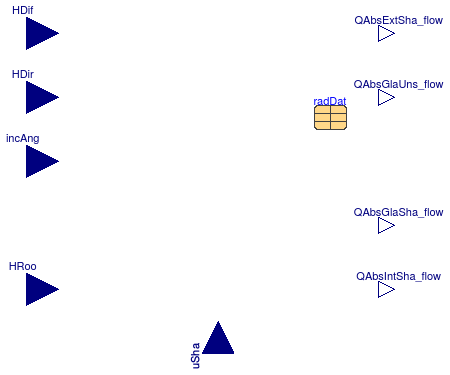
The model calculates absorbed solar radiation on the window. The calculations follow the description in Wetter (2004), Appendix A.4.3.
The absorbed radiation by exterior shades includes:
AWin*uSha*(HDir+HDif)*(1-tau-rho)
AWin*uSha*HDir*tau*rho(IncAng)*(1-tau-rho)
AWin*uSha*HDif*tau*rho(HEM)*(1-tau-rho)
The output is absRad[2, 1]
The absorbed radiation by interior shades includes:
AWin*uSha*HDir*alpha(IncAng)
AWin*uSha*HDif*alpha(HEM)
AWin*uSha*HRoo*(1-tau-rho)
The output is absRad[2, N+2]
The absorbed radiation by glass includes:
AWin*(1-uSha)*(HDif*alphaEx(HEM)+HRoo*alphaIn(HEM))
AWin*(1-uSha)*HDir*alphaEx(IncAng)
AWin*uSha*(HDif*alphaExSha(HEM)+HRoo*alphaInSha(HEM))
AWin*uSha*HDir*alphaExSha(IncAng)
The output is absRad[1, 2:N+1] = Part1 + Part2; absRad[2, 2:N+1] = Part3 + Part4
Extends from Buildings.HeatTransfer.Windows.BaseClasses.PartialRadiation (Partial model for variables and data used in radiation calculation).
| Type | Name | Default | Description |
|---|---|---|---|
| Boolean | haveExteriorShade | Set to true if window has an exterior shade | |
| Boolean | haveInteriorShade | Set to true if window has an interior shade | |
| Area | AWin | Area of window [m2] | |
| Glass | |||
| Integer | N | Number of glass layers | |
| Length | xGla[N] | Thickness of glass [m] | |
| TransmissionCoefficient | tauGlaSol[N, :] | Solar transmissivity of glass [1] | |
| ReflectionCoefficient | rhoGlaSol_a[N, NSta] | Solar reflectivity of glass at surface a (facing outside) [1] | |
| ReflectionCoefficient | rhoGlaSol_b[N, NSta] | Solar reflectivity of glass at surface b (facing room-side) [1] | |
| Shade | |||
| TransmissionCoefficient | tauShaSol_a | Solar transmissivity of shade for irradiation from air-side [1] | |
| TransmissionCoefficient | tauShaSol_b | Solar transmissivity of shade for irradiation from glass-side [1] | |
| ReflectionCoefficient | rhoShaSol_a | Solar reflectivity of shade for irradiation from air-side [1] | |
| ReflectionCoefficient | rhoShaSol_b | Solar reflectivity of shade for irradiation from glass-side [1] | |
| Type | Name | Description |
|---|---|---|
| input RealInput | uSha | Control signal for shading (0: unshaded; 1: fully shaded) |
| input RealInput | HDif | Diffussive solar radiation [W/m2] |
| input RealInput | incAng | Incident angle [rad] |
| input RealInput | HDir | Direct solar radiation [W/m2] |
| input RealInput | HRoo | Diffussive radiation from room [W/m2] |
| output RealOutput | QAbsExtSha_flow[NSta] | Absorbed interior and exterior radiation by exterior shading device [W] |
| output RealOutput | QAbsIntSha_flow[NSta] | Absorbed interior and exterior radiation by interior shading device [W] |
| output RealOutput | QAbsGlaUns_flow[N, NSta] | Absorbed interior and exterior radiation by unshaded part of glass [W] |
| output RealOutput | QAbsGlaSha_flow[N, NSta] | Absorbed interior and exterior radiation by shaded part of glass [W] |
 Buildings.HeatTransfer.Windows.BaseClasses.CenterOfGlass
Buildings.HeatTransfer.Windows.BaseClasses.CenterOfGlass
Model for center of glass of a window construction
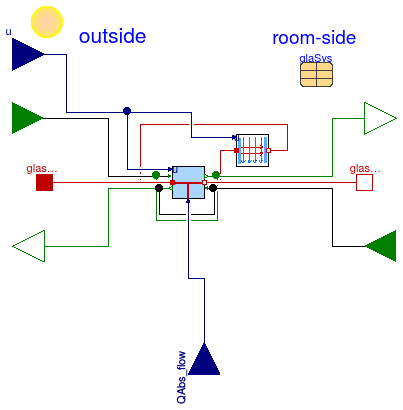
glaSys.
The model contains these main component models:
extSha and intSha
for the heat balance of the shade, modeled using
Buildings.HeatTransfer.Windows.BaseClasses.Shade.
glass for the heat conduction and the
infrared radiative heat balance of the glass layers.
There can be an arbitrary number of glass layers, which are all modeled using
instances of
Buildings.HeatTransfer.Windows.BaseClasses.GlassLayer.
gas for the gas layers. There is one model of a
gas layer between each window panes. The gas layers are modeled using instances of
Buildings.HeatTransfer.Windows.BaseClasses.GasConvection.
Extends from Buildings.HeatTransfer.Radiosity.BaseClasses.RadiosityTwoSurfaces (Model for the radiosity balance of a device with two surfaces).
| Type | Name | Default | Description |
|---|---|---|---|
| Area | A | Surface area [m2] | |
| Angle | til | Surface tilt (only 90 degrees=vertical is implemented) [rad] | |
| Generic | glaSys | Glazing system | |
| Boolean | linearize | false | Set to true to linearize emissive power |
| Advanced | |||
| Boolean | homotopyInitialization | true | = true, use homotopy method |
| Type | Name | Description |
|---|---|---|
| input RadiosityInflow | JIn_a | Incoming radiosity at surface a [W] |
| input RadiosityInflow | JIn_b | Incoming radiosity at surface b [W] |
| output RadiosityOutflow | JOut_a | Outgoing radiosity at surface a [W] |
| output RadiosityOutflow | JOut_b | Outgoing radiosity at surface b [W] |
| input RealInput | u | Input connector, used to scale the surface area to take into account an operable shading device |
| HeatPort_a | glass_a | Heat port connected to the outside facing surface of the glass |
| HeatPort_b | glass_b | Heat port connected to the room-facing surface of the glass |
| input RealInput | QAbs_flow[nGlaLay] | Solar radiation absorbed by glass [W] |
 Buildings.HeatTransfer.Windows.BaseClasses.ExteriorConvectionCoefficient
Buildings.HeatTransfer.Windows.BaseClasses.ExteriorConvectionCoefficient
Model for the heat transfer coefficient at the outside of the window

h = 4+4 v
where v is the wind speed in m/s and h is the convective heat transfer coefficient in W/(m2*K).Extends from Modelica.Blocks.Icons.Block (Basic graphical layout of input/output block).
| Type | Name | Default | Description |
|---|---|---|---|
| Area | A | Heat transfer area [m2] |
| Type | Name | Description |
|---|---|---|
| output RealOutput | GCon | Convective thermal conductance [W/K] |
| input RealInput | v | Wind speed [m/s] |
 Buildings.HeatTransfer.Windows.BaseClasses.GasConvection
Buildings.HeatTransfer.Windows.BaseClasses.GasConvection
Model for heat convection through gas in a window assembly

To use this model, set the parameter til
to a value defined in
Buildings.Types.Tilt.
If the parameter linearize is set to true,
then all equations are linearized.
Extends from Modelica.Thermal.HeatTransfer.Interfaces.Element1D (Partial heat transfer element with two HeatPort connectors that does not store energy), Buildings.BaseClasses.BaseIcon (Base icon).
| Type | Name | Default | Description |
|---|---|---|---|
| Generic | gas | Thermophysical properties of gas fill | |
| Area | A | Heat transfer area [m2] | |
| Area | h | sqrt(A) | Height of window [m2] |
| Angle | til | Surface tilt (only 0, 90 and 180 degrees are implemented) [rad] | |
| Boolean | linearize | false | Set to true to linearize emissive power |
| Temperature | T0 | 293.15 | Temperature used to compute thermophysical properties [K] |
| Advanced | |||
| Boolean | homotopyInitialization | true | = true, use homotopy method |
| Type | Name | Description |
|---|---|---|
| input RealInput | u | Input connector, used to scale the surface area to take into account an operable shading device |
 Buildings.HeatTransfer.Windows.BaseClasses.GlassLayer
Buildings.HeatTransfer.Windows.BaseClasses.GlassLayer
Model for a glass layer of a window assembly
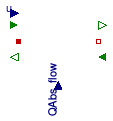
QAbs_flow
needs to be connected to the solar radiation that is absorbed
by the glass pane.
The model computes the heat conduction between the two glass surfaces.
The heat flow QAbs_flow is added at the center of the glass.
The model also computes the infrared radiative heat balance using an instance
of the model
Buildings.HeatTransfer.Radiosity.WindowPane.
Extends from Buildings.HeatTransfer.Radiosity.BaseClasses.RadiosityTwoSurfaces (Model for the radiosity balance of a device with two surfaces), Buildings.HeatTransfer.Radiosity.BaseClasses.ParametersTwoSurfaces (Parameters that are used to model two surfaces with the same area).
| Type | Name | Default | Description |
|---|---|---|---|
| Area | A | Surface area [m2] | |
| Emissivity | absIR_a | Infrared absorptivity of surface a [1] | |
| Emissivity | absIR_b | Infrared absorptivity of surface b [1] | |
| ReflectionCoefficient | rhoIR_a | 1 - absIR_a - tauIR | Infrared reflectivity of surface a [1] |
| ReflectionCoefficient | rhoIR_b | 1 - absIR_b - tauIR | Infrared reflectivity of surface b [1] |
| TransmissionCoefficient | tauIR | Infrared transmissivity of glass pane [1] | |
| Boolean | linearize | false | Set to true to linearize emissive power |
| Temperature | T0 | 293.15 | Temperature used to linearize radiative heat transfer [K] |
| Length | x | Material thickness [m] | |
| ThermalConductivity | k | Thermal conductivity [W/(m.K)] | |
| Advanced | |||
| Boolean | homotopyInitialization | true | = true, use homotopy method |
| Type | Name | Description |
|---|---|---|
| input RadiosityInflow | JIn_a | Incoming radiosity at surface a [W] |
| input RadiosityInflow | JIn_b | Incoming radiosity at surface b [W] |
| output RadiosityOutflow | JOut_a | Outgoing radiosity at surface a [W] |
| output RadiosityOutflow | JOut_b | Outgoing radiosity at surface b [W] |
| input RealInput | u | Input connector, used to scale the surface area to take into account an operable shading device |
| HeatPort_a | port_a | Heat port at surface a |
| HeatPort_b | port_b | Heat port at surface b |
| input RealInput | QAbs_flow | Solar radiation absorbed by glass [W] |
 Buildings.HeatTransfer.Windows.BaseClasses.InteriorConvection
Buildings.HeatTransfer.Windows.BaseClasses.InteriorConvection
Model for a interior (room-side) convective heat transfer with variable surface area

This is a model for a convective heat transfer for interior, room-facing surfaces.
The parameter conMod determines the model that is used to compute
the heat transfer coefficient:
conMod=
Buildings.HeatTransfer.Types.InteriorConvection.Fixed, then
the convective heat transfer coefficient is set to the value specified by the parameter
hFixed.
conMod=
Buildings.HeatTransfer.Types.InteriorConvection.Temperature, then
the convective heat tranfer coefficient is a function of the temperature difference.
The convective heat flux is computed using
This model is identical to
Buildings.HeatTransfer.Convection.Interior
except that it has an input u that is used to scale the
heat transfer.
This can be used if the heat transfer area is variable.
An example usage is for a window with shade, in which
the surface area of a shaded part of a window changes depending on the shading
control signal.
Extends from Buildings.HeatTransfer.Convection.BaseClasses.PartialConvection (Partial model for heat convection).
| Type | Name | Default | Description |
|---|---|---|---|
| Area | A | Heat transfer area [m2] | |
| CoefficientOfHeatTransfer | hFixed | 3 | Constant convection coefficient [W/(m2.K)] |
| Angle | til | Surface tilt [rad] | |
| InteriorConvection | conMod | Buildings.HeatTransfer.Types... | Convective heat transfer model |
| Initialization | |||
| TemperatureDifference | dT.start | 0 | = solid.T - fluid.T [K] |
| Advanced | |||
| Boolean | homotopyInitialization | true | = true, use homotopy method |
| Type | Name | Description |
|---|---|---|
| HeatPort_a | solid | |
| HeatPort_b | fluid | |
| input RealInput | u | Input connector, used to scale the surface area to take into account an operable shading device |
 Buildings.HeatTransfer.Windows.BaseClasses.InteriorConvectionCoefficient
Buildings.HeatTransfer.Windows.BaseClasses.InteriorConvectionCoefficient
Model for the heat transfer coefficient at the inside of the window

h = 4 W ⁄ (m2 K).
TARCOG 2006: Carli, Inc., TARCOG: Mathematical models for calculation of thermal performance of glazing systems with our without shading devices, Technical Report, Oct. 17, 2006.
Extends from Modelica.Blocks.Icons.Block (Basic graphical layout of input/output block).
| Type | Name | Default | Description |
|---|---|---|---|
| Area | A | Heat transfer area [m2] |
| Type | Name | Description |
|---|---|---|
| output RealOutput | GCon | Convective thermal conductance [W/K] |
 Buildings.HeatTransfer.Windows.BaseClasses.Overhang
Buildings.HeatTransfer.Windows.BaseClasses.Overhang
For a window with an overhang, outputs the fraction of the area that is sun exposed
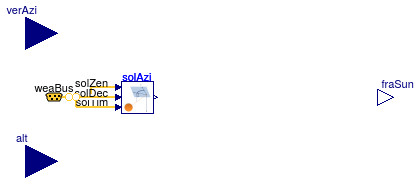
For a window with an overhang, this block outputs the fraction of the area that is exposed to the sun. This models can also be used for doors with an overhang.
Input to this block are the wall solar azimuth angle and the altitude angle of the sun. These angles can be calculated using blocks from the package Buildings.BoundaryConditions.SolarGeometry.BaseClasses.
The overhang can be asymmetrical (i.e. wR ≠ wL)
about the vertical centerline
of the window.
The overhang must completely cover the window (i.e.,
wL ≥ 0 and
wR ≥ 0).
wL and wR are measured from the left and right edge of the window.
The surface azimuth azi is as defined in
Buildings.Types.Azimuth.
The method of super position is used to calculate the window shaded area. The area below the overhang is divided as shown in the figure.
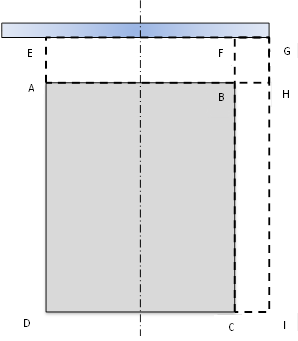
Dimensional variables used in code for the rectangle DEGI, AEGH, CFGI and BFGH are shown in the figure below:
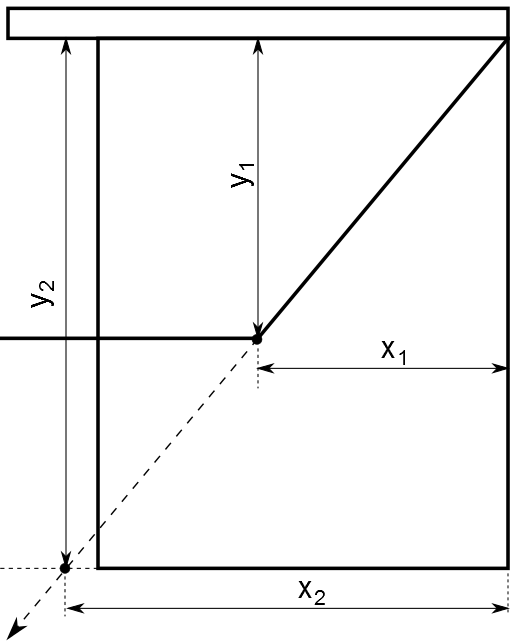
The rectangles DEGI, AEGH, CFGI and BFGH have the same geometric configuration
with respect to the overhang.
Thus, the same algorithm can be used to calculate the shaded portion in these areas.
A single equation in the for loop improves the total calculation time,
as compared to if-then-else
conditions, considering the various shapes of the shaded portions.
To find the shaded area in window ABCD, the shaded portion of AEGD and CFGI
should be subtracted from that of DEGI and BFGH.
This shaded area of the window is then divided by the total window area
to calculate the shaded fraction of the window.
Extends from Modelica.Blocks.Icons.Block (Basic graphical layout of input/output block), Buildings.Rooms.BaseClasses.Overhang (Record for window overhang).
| Type | Name | Default | Description |
|---|---|---|---|
| Angle | lat | Latitude [rad] | |
| Angle | azi | Surface azimuth; azi= -90 degree East; azi= 0 degree South [rad] | |
| Overhang | |||
| Length | wL | Overhang width left to the window, measured from the window corner [m] | |
| Length | wR | Overhang width right to the window, measured from the window corner [m] | |
| Length | dep | Overhang depth (measured perpendicular to the wall plane) [m] | |
| Length | gap | Distance between window upper edge and overhang lower edge [m] | |
| Window | |||
| Length | hWin | Window height [m] | |
| Length | wWin | Window width [m] | |
| Type | Name | Description |
|---|---|---|
| input RealInput | verAzi | Wall solar azimuth angle (angle between projection of sun's rays and normal to vertical surface) [rad] |
| input RealInput | alt | Altitude angle [rad] |
| output RealOutput | fraSun | Fraction of window area exposed to the sun [1] |
| Bus | weaBus | Weather data |
 Buildings.HeatTransfer.Windows.BaseClasses.PartialRadiation
Buildings.HeatTransfer.Windows.BaseClasses.PartialRadiation
Partial model for variables and data used in radiation calculation
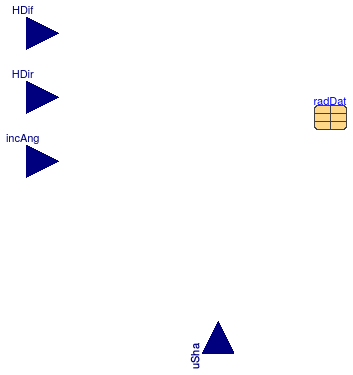
Extends from Modelica.Blocks.Icons.Block (Basic graphical layout of input/output block), Buildings.HeatTransfer.Windows.BaseClasses.RadiationBaseData (Basic parameters for window radiation calculation).
| Type | Name | Default | Description |
|---|---|---|---|
| Boolean | haveExteriorShade | Set to true if window has an exterior shade | |
| Boolean | haveInteriorShade | Set to true if window has an interior shade | |
| Area | AWin | Area of window [m2] | |
| Glass | |||
| Integer | N | Number of glass layers | |
| Length | xGla[N] | Thickness of glass [m] | |
| TransmissionCoefficient | tauGlaSol[N, :] | Solar transmissivity of glass [1] | |
| ReflectionCoefficient | rhoGlaSol_a[N, NSta] | Solar reflectivity of glass at surface a (facing outside) [1] | |
| ReflectionCoefficient | rhoGlaSol_b[N, NSta] | Solar reflectivity of glass at surface b (facing room-side) [1] | |
| Shade | |||
| TransmissionCoefficient | tauShaSol_a | Solar transmissivity of shade for irradiation from air-side [1] | |
| TransmissionCoefficient | tauShaSol_b | Solar transmissivity of shade for irradiation from glass-side [1] | |
| ReflectionCoefficient | rhoShaSol_a | Solar reflectivity of shade for irradiation from air-side [1] | |
| ReflectionCoefficient | rhoShaSol_b | Solar reflectivity of shade for irradiation from glass-side [1] | |
| Type | Name | Description |
|---|---|---|
| input RealInput | uSha | Control signal for shading (0: unshaded; 1: fully shaded) |
| input RealInput | HDif | Diffussive solar radiation [W/m2] |
| input RealInput | incAng | Incident angle [rad] |
| input RealInput | HDir | Direct solar radiation [W/m2] |
 Buildings.HeatTransfer.Windows.BaseClasses.PartialShade_weatherBus
Buildings.HeatTransfer.Windows.BaseClasses.PartialShade_weatherBus
Partial model to implement overhang and side fins with weather bus connector
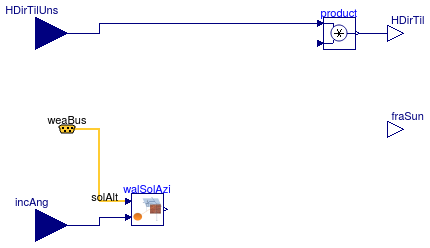
Partial model to implement overhang and side fin model with weather bus as a connector.
Extends from Buildings.HeatTransfer.Windows.BaseClasses.ShadeInterface_weatherBus (Base class for models of window shade and overhangs).
| Type | Name | Default | Description |
|---|---|---|---|
| Window | |||
| Length | hWin | Window height [m] | |
| Length | wWin | Window width [m] | |
| Type | Name | Description |
|---|---|---|
| Bus | weaBus | Weather data bus |
| input RealInput | incAng | Solar incidence angle [rad] |
| input RealInput | HDirTilUns | Direct solar irradiation on tilted, unshaded surface [W/m2] |
| output RealOutput | HDirTil | Direct solar irradiation on tilted, shaded surface [W/m2] |
| output RealOutput | fraSun | Fraction of the area that is unshaded [1] |
 Buildings.HeatTransfer.Windows.BaseClasses.PartialWindowBoundaryCondition
Buildings.HeatTransfer.Windows.BaseClasses.PartialWindowBoundaryCondition
Partial model for heat convection or radiation between a possibly shaded window that can be outside or inside the room

Partial model for boundary conditions for convection and radiation for a window surface with or without shade, that is outside or inside the room.
This allows using the model as a base class for windows with inside shade, outside shade, or no shade.
| Type | Name | Default | Description |
|---|---|---|---|
| Area | A | Heat transfer area of frame and window [m2] | |
| Real | fFra | Fraction of window frame divided by total window area | |
| Shading | |||
| Boolean | haveExteriorShade | Set to true if window has exterior shade (at surface a) | |
| Boolean | haveInteriorShade | Set to true if window has interior shade (at surface b) | |
| Boolean | thisSideHasShade | Set to true if this side of the model has a shade | |
| Type | Name | Description |
|---|---|---|
| input RealInput | uSha | Input connector, used to scale the surface area to take into account an operable shading device, 0: unshaded; 1: fully shaded |
| HeatPort_a | air | Port that connects to the air (room or outside) |
| HeatPort_b | glaUns | Heat port that connects to unshaded part of glass |
| HeatPort_b | glaSha | Heat port that connects to shaded part of glass |
| HeatPort_a | frame | Heat port at window frame |
 Buildings.HeatTransfer.Windows.BaseClasses.ShadeConvection
Buildings.HeatTransfer.Windows.BaseClasses.ShadeConvection
Model for convective heat balance of a layer that may or may not have a shade
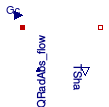
Model for the convective heat balance of a shade that is in the outside or the room-side of a window.
The convective heat balance is based on the model described by Wright (2008), which can be shown as a convective heat resistance model as follows:
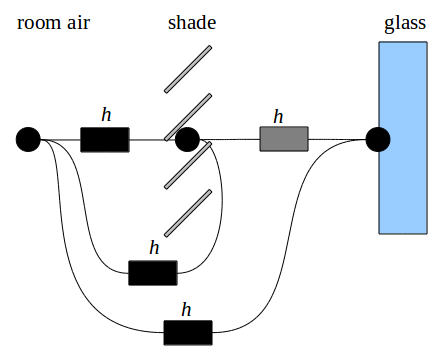
Wright (2008) reports that if the shading layer is far enough from the window, the boundary layers associated with each surface will not interfere with each other. In this case, it is reasonable to consider each surface on an individual basis by setting the convective heat transfer coefficient shown in grey to zero, and setting the black depicted convective heat transfer coefficients to h=4 W/m2 K. In the here implemented model, the grey depicted convective heat transfer coefficient is set set to h' = k h, where 0 ≤ k ≤ 1 is a parameter.
| Type | Name | Default | Description |
|---|---|---|---|
| Area | A | Heat transfer area [m2] | |
| Boolean | thisSideHasShade | Set to true if this side of the window has a shade | |
| Real | k | 1 | Coefficient used to scale convection between shade and glass |
| Type | Name | Description |
|---|---|---|
| input RealInput | Gc | Signal representing the convective thermal conductance [W/K] |
| HeatPort_a | air | Port that connects to the air (room or outside) |
| HeatPort_b | glass | Heat port that connects to shaded part of glass |
| input RealInput | QRadAbs_flow | Total net radiation that is absorbed by the shade (positive if absorbed) [W] |
| output RealOutput | TSha | Shade temperature [K] |
 Buildings.HeatTransfer.Windows.BaseClasses.ShadeInterface_weatherBus
Buildings.HeatTransfer.Windows.BaseClasses.ShadeInterface_weatherBus
Base class for models of window shade and overhangs

Partial model to implement overhang and side fin model with weather bus as a connector.
Extends from Modelica.Blocks.Icons.Block (Basic graphical layout of input/output block).
| Type | Name | Description |
|---|---|---|
| Bus | weaBus | Weather data bus |
| input RealInput | incAng | Solar incidence angle [rad] |
| input RealInput | HDirTilUns | Direct solar irradiation on tilted, unshaded surface [W/m2] |
| output RealOutput | HDirTil | Direct solar irradiation on tilted, shaded surface [W/m2] |
| output RealOutput | fraSun | Fraction of the area that is unshaded [1] |
 Buildings.HeatTransfer.Windows.BaseClasses.ShadeRadiation
Buildings.HeatTransfer.Windows.BaseClasses.ShadeRadiation
Model for infrared radiative heat balance of a layer that may or may not have a shade
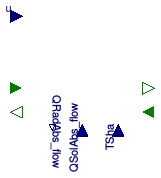
Model for the infrared radiative heat balance of a shade that is at the outside or the room-side of a window. The model also includes the absorbed solar radiation.
The input port QAbs_flow needs to be connected to the solar radiation
that is absorbed by the shade.
| Type | Name | Default | Description |
|---|---|---|---|
| Area | A | Heat transfer area [m2] | |
| Emissivity | absIR_air | Infrared absorptivity of surface that faces air [1] | |
| Emissivity | absIR_glass | Infrared absorptivity of surface that faces glass [1] | |
| TransmissionCoefficient | tauIR_air | Infrared transmissivity of shade for radiation coming from the exterior or the room [1] | |
| TransmissionCoefficient | tauIR_glass | Infrared transmissivity of shade for radiation coming from the glass [1] | |
| Boolean | thisSideHasShade | Set to true if this side of the window has a shade | |
| Boolean | linearize | false | Set to true to linearize emissive power |
| Temperature | T0 | 293.15 | Temperature used to linearize radiative heat transfer [K] |
| Advanced | |||
| Boolean | homotopyInitialization | true | = true, use homotopy method |
| Type | Name | Description |
|---|---|---|
| input RealInput | u | Input connector, used to scale the surface area to take into account an operable shading device |
| input RealInput | QSolAbs_flow | Solar radiation absorbed by shade [W] |
| input RadiosityInflow | JIn_air | Incoming radiosity at the air-side surface of the shade [W] |
| input RadiosityInflow | JIn_glass | Incoming radiosity at the glass-side surface of the shade [W] |
| output RadiosityOutflow | JOut_air | Outgoing radiosity at the air-side surface of the shade [W] |
| output RadiosityOutflow | JOut_glass | Outgoing radiosity at the glass-side surface of the shade [W] |
| output RealOutput | QRadAbs_flow | Total net radiation that is absorbed by the shade (positive if absorbed) [W] |
| input RealInput | TSha | Shade temperature [K] |
 Buildings.HeatTransfer.Windows.BaseClasses.ShadingSignal
Buildings.HeatTransfer.Windows.BaseClasses.ShadingSignal
Converts the shading signal to be strictly bigger than 0 and smaller than 1

u
or by 1-u (if a shade is present), the heat balance can be singular
for u=0 or for u=1.
This model avoids this singularity by slightly changing the control signal.
Extends from Modelica.Blocks.Interfaces.SO (Single Output continuous control block).
| Type | Name | Default | Description |
|---|---|---|---|
| Boolean | haveShade | Set to true if a shade is present |
| Type | Name | Description |
|---|---|---|
| output RealOutput | y | Connector of Real output signal |
| input RealInput | u | Shading control signal, 0: unshaded; 1: fully shaded |
| output RealOutput | yCom | 1-u |
 Buildings.HeatTransfer.Windows.BaseClasses.SideFins
Buildings.HeatTransfer.Windows.BaseClasses.SideFins
For a window with side fins, outputs the fraction of the area that is sun exposed

For a window with side fins, this block outputs the fraction of the area that is exposed to the sun. This models can also be used for doors with side fins.
Input to this block are the wall solar azimuth angle and the altitude angle of the sun. These angles can be calculated using blocks from the package Buildings.BoundaryConditions.SolarGeometry.BaseClasses.
The model assumes that
The method of super position is used to calculate the shaded area of the window. The area besides the side fin is divided as shown in the figure below.
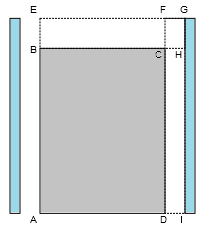
Variables used in the code for the rectangle AEGI, BEGH, DFGI and CFGH are shown in figure below.
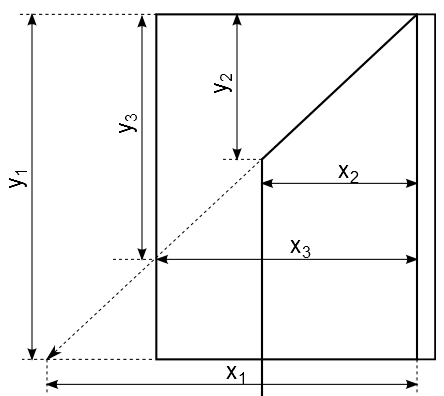
The rectangles AEGI, BEGH, DFGI and CFGH have the same geometric configuration
with respect to the side fin.
Thus, the same algorithm is used to calculate the shaded portion in these areas.
A single equation in the for loop improves the total calculation time,
as compared to if-then-else
conditions, considering the various shapes of the shaded portions.
To find the shaded area in the window ABCD, the shaded portion of
BEGH and DFGI is subtracted from AEGI and CFGH.
This shaded area of the window is then divided by the total window area
to calculate the shaded fraction of the window.
Extends from Modelica.Blocks.Icons.Block (Basic graphical layout of input/output block), Buildings.Rooms.BaseClasses.SideFins (Record for window side fins).
| Type | Name | Default | Description |
|---|---|---|---|
| Side fin | |||
| Length | h | Height of side fin that extends above window, measured from top of window [m] | |
| Length | dep | Side fin depth (measured perpendicular to the wall plane) [m] | |
| Length | gap | Distance between side fin and window edge [m] | |
| Window | |||
| Length | hWin | Window height [m] | |
| Length | wWin | Window width [m] | |
| Type | Name | Description |
|---|---|---|
| input RealInput | alt | Solar altitude angle (angle between sun ray and horizontal surface) [rad] |
| input RealInput | verAzi | Angle between projection of sun's rays and normal to vertical surface [rad] |
| output RealOutput | fraSun | Fraction of window area exposed to the sun [1] |
 Buildings.HeatTransfer.Windows.BaseClasses.StateInterpolator
Buildings.HeatTransfer.Windows.BaseClasses.StateInterpolator
Block to interpolate between different window states

This block interpolates the radiation data for the actual
state of the window.
For windows with only one state, e.g., conventional windows,
this block outputs H=HSta[1].
For windows with multiple states, it outputs the
interpolated radiation using cubic spline interpolation.
Extends from Modelica.Blocks.Interfaces.BlockIcon (This icon will be removed in future Modelica versions, use Modelica.Blocks.Icons.Block instead.).
| Type | Name | Default | Description |
|---|---|---|---|
| Integer | NSta | Number of window states for electrochromic windows |
| Type | Name | Description |
|---|---|---|
| input RealInput | uSta | Control signal for window state [1] |
| input RealInput | HSta[NSta] | Radiation for each window state |
| output RealOutput | H | Interpolated radiation |
 Buildings.HeatTransfer.Windows.BaseClasses.ThermalConductor
Buildings.HeatTransfer.Windows.BaseClasses.ThermalConductor
Lumped thermal element with variable area, transporting heat without storing it

This is a model for transport of heat without storing it.
It is identical to the thermal conductor from the Modelica Standard Library,
except that it adds an input signal u.
Extends from Modelica.Thermal.HeatTransfer.Interfaces.Element1D (Partial heat transfer element with two HeatPort connectors that does not store energy).
| Type | Name | Default | Description |
|---|---|---|---|
| ThermalConductance | G | Constant thermal conductance of material [W/K] |
| Type | Name | Description |
|---|---|---|
| HeatPort_a | port_a | |
| HeatPort_b | port_b | |
| input RealInput | u | Input signal for thermal conductance |
 Buildings.HeatTransfer.Windows.BaseClasses.TransmittedRadiation
Buildings.HeatTransfer.Windows.BaseClasses.TransmittedRadiation
Transmitted radiation through window
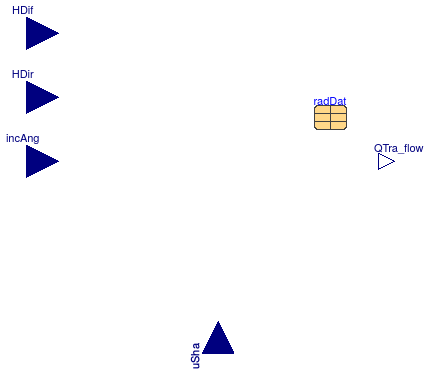
AWin*(1-uSha)*HDif*tau(HEM)
AWin*(1-uSha)*HDir*tau(IncAng)
AWin*uSha*HDif*tauSha(HEM)
AWin*uSha*HDir*tauSha(IncAng);
QTra_flow = Part1 + Part2 + Part3 + Part4
Extends from Buildings.HeatTransfer.Windows.BaseClasses.PartialRadiation (Partial model for variables and data used in radiation calculation).
| Type | Name | Default | Description |
|---|---|---|---|
| Boolean | haveExteriorShade | Set to true if window has an exterior shade | |
| Boolean | haveInteriorShade | Set to true if window has an interior shade | |
| Area | AWin | Area of window [m2] | |
| Glass | |||
| Integer | N | Number of glass layers | |
| Length | xGla[N] | Thickness of glass [m] | |
| TransmissionCoefficient | tauGlaSol[N, :] | Solar transmissivity of glass [1] | |
| ReflectionCoefficient | rhoGlaSol_a[N, NSta] | Solar reflectivity of glass at surface a (facing outside) [1] | |
| ReflectionCoefficient | rhoGlaSol_b[N, NSta] | Solar reflectivity of glass at surface b (facing room-side) [1] | |
| Shade | |||
| TransmissionCoefficient | tauShaSol_a | Solar transmissivity of shade for irradiation from air-side [1] | |
| TransmissionCoefficient | tauShaSol_b | Solar transmissivity of shade for irradiation from glass-side [1] | |
| ReflectionCoefficient | rhoShaSol_a | Solar reflectivity of shade for irradiation from air-side [1] | |
| ReflectionCoefficient | rhoShaSol_b | Solar reflectivity of shade for irradiation from glass-side [1] | |
| Type | Name | Description |
|---|---|---|
| input RealInput | uSha | Control signal for shading (0: unshaded; 1: fully shaded) |
| input RealInput | HDif | Diffussive solar radiation [W/m2] |
| input RealInput | incAng | Incident angle [rad] |
| input RealInput | HDir | Direct solar radiation [W/m2] |
| output RealOutput | QTra_flow[NSta] | Transmitted exterior radiation through the window. (1: no shade; 2: shade) [W] |
 Buildings.HeatTransfer.Windows.BaseClasses.WindowRadiation
Buildings.HeatTransfer.Windows.BaseClasses.WindowRadiation
Calculation radiation for window
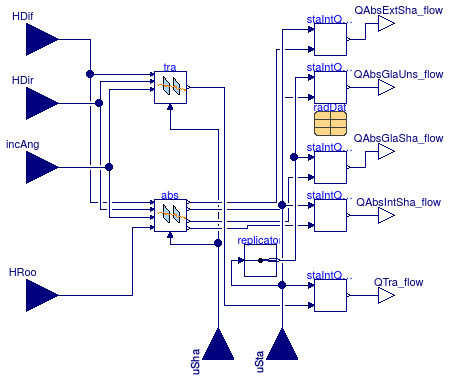
The model calculates solar radiation through the window. The calculations follow the description in Wetter (2004), Appendix A.4.3. with the difference that this implementation allows a window to have multiple states, thereby allowing to model electrochromic windows.
The absorbed radiation by exterior shades includes:
AWin*uSha*(HDir+HDif)*(1-tau-rho)
AWin*uSha*HDir*tau*rho(IncAng)*(1-tau-rho)
AWin*uSha*HDif*tau*rho(HEM)*(1-tau-rho)
The output is absRad[2, 1]
The absorbed radiation by interior shades includes:
AWin*uSha*HDir*alpha(IncAng)
AWin*uSha*HDif*alpha(HEM)
AWin*uSha*HRoo*(1-tau-rho)
The output is absRad[2, N+2]
The absorbed radiation by glass includes:
AWin*(1-uSha)*(HDif*alphaEx(HEM)+HRoo*alphaIn(HEM))
AWin*(1-uSha)*HDir*alphaEx(IncAng)
AWin*uSha*(HDif*alphaExSha(HEM)+HRoo*alphaInSha(HEM))
AWin*uSha*HDir*alphaExSha(IncAng)
The output is absRad[1, 2:N+1] = Part1 + Part2; absRad[2, 2:N+1] = Part3 + Part4
The transmitted exterior radiation for window system includes:
AWin*(1-uSha)*HDif*tau(HEM)
AWin*(1-uSha)*HDir*tau(IncAng)
AWin*uSha*HDif*tauSha(HEM)
AWin*uSha*HDir*tauSha(IncAng);
The output is QTra_flow = Part1 + Part2 + Part3 + Part4
Extends from Buildings.HeatTransfer.Windows.BaseClasses.PartialRadiation (Partial model for variables and data used in radiation calculation).
| Type | Name | Default | Description |
|---|---|---|---|
| Boolean | haveExteriorShade | Set to true if window has an exterior shade | |
| Boolean | haveInteriorShade | Set to true if window has an interior shade | |
| Area | AWin | Area of window [m2] | |
| Glass | |||
| Integer | N | Number of glass layers | |
| Length | xGla[N] | Thickness of glass [m] | |
| TransmissionCoefficient | tauGlaSol[N, :] | Solar transmissivity of glass [1] | |
| ReflectionCoefficient | rhoGlaSol_a[N, NSta] | Solar reflectivity of glass at surface a (facing outside) [1] | |
| ReflectionCoefficient | rhoGlaSol_b[N, NSta] | Solar reflectivity of glass at surface b (facing room-side) [1] | |
| Shade | |||
| TransmissionCoefficient | tauShaSol_a | Solar transmissivity of shade for irradiation from air-side [1] | |
| TransmissionCoefficient | tauShaSol_b | Solar transmissivity of shade for irradiation from glass-side [1] | |
| ReflectionCoefficient | rhoShaSol_a | Solar reflectivity of shade for irradiation from air-side [1] | |
| ReflectionCoefficient | rhoShaSol_b | Solar reflectivity of shade for irradiation from glass-side [1] | |
| Type | Name | Description |
|---|---|---|
| input RealInput | uSha | Control signal for shading (0: unshaded; 1: fully shaded) |
| input RealInput | HDif | Diffussive solar radiation [W/m2] |
| input RealInput | incAng | Incident angle [rad] |
| input RealInput | HDir | Direct solar radiation [W/m2] |
| input RealInput | uSta | Control signal for window state [1] |
| input RealInput | HRoo | Diffussive radiation from room [W/m2] |
| output RealOutput | QTra_flow | Transmitted exterior radiation through the window. (1: no shade; 2: shade) [W] |
| output RealOutput | QAbsExtSha_flow | Absorbed interior and exterior radiation by exterior shading device [W] |
| output RealOutput | QAbsIntSha_flow | Absorbed interior and exterior radiation by interior shading device [W] |
| output RealOutput | QAbsGlaUns_flow[N] | Absorbed interior and exterior radiation by unshaded part of glass [W] |
| output RealOutput | QAbsGlaSha_flow[N] | Absorbed interior and exterior radiation by shaded part of glass [W] |
Free convection in horizontal cavity
Function for convective heat transfer in horizontal window cavity. The computation is according to TARCOG 2006, except that this implementation computes the convection coefficient as a function that is differentiable in the temperatures.
TARCOG 2006: Carli, Inc., TARCOG: Mathematical models for calculation of thermal performance of glazing systems with our without shading devices, Technical Report, Oct. 17, 2006.
| Type | Name | Default | Description |
|---|---|---|---|
| Generic | gas | Thermophysical properties of gas fill | |
| Real | Ra | Rayleigh number | |
| Temperature | T_m | Temperature used for thermophysical properties [K] | |
| TemperatureDifference | dT | Temperature difference used to compute q_flow = h*dT [K] | |
| Angle | til | Window tilt [rad] | |
| Real | sinTil | Sine of window tilt | |
| Real | cosTil | Cosine of the window tilt | |
| Area | h | 1.5 | Height of window [m2] |
| Real | deltaNu | 0.1 | Small value for Nusselt number, used for smoothing |
| Real | deltaRa | 1E3 | Small value for Rayleigh number, used for smoothing |
| Type | Name | Description |
|---|---|---|
| Real | Nu | Nusselt number |
| CoefficientOfHeatTransfer | hCon | Convective heat transfer coefficient [W/(m2.K)] |
| HeatFlux | q_flow | Convective heat flux [W/m2] |
Free convection in vertical cavity
Function for convective heat transfer in vertical window cavity. The computation is according to TARCOG 2006, except that this implementation computes the convection coefficient as a function that is differentiable in the temperatures.
TARCOG 2006: Carli, Inc., TARCOG: Mathematical models for calculation of thermal performance of glazing systems with our without shading devices, Technical Report, Oct. 17, 2006.
| Type | Name | Default | Description |
|---|---|---|---|
| Generic | gas | Thermophysical properties of gas fill | |
| Real | Ra | Rayleigh number | |
| Temperature | T_m | Temperature used for thermophysical properties [K] | |
| TemperatureDifference | dT | Temperature difference used to compute q_flow = h*dT [K] | |
| Area | h | 1.5 | Height of window [m2] |
| Real | deltaNu | 0.1 | Small value for Nusselt number, used for smoothing |
| Real | deltaRa | 1E3 | Small value for Rayleigh number, used for smoothing |
| Type | Name | Description |
|---|---|---|
| Real | Nu | Nusselt number |
| CoefficientOfHeatTransfer | hCon | Convective heat transfer coefficient [W/(m2.K)] |
| HeatFlux | q_flow | Convective heat flux [W/m2] |
Nusselt number for horizontal cavity, bottom surface warmer than top surface
Function for Nusselt number in horizontal window cavity. The computation is according to TARCOG 2006, except that this implementation computes the Nusselt number as a function that is differentiable in the temperatures.
TARCOG 2006: Carli, Inc., TARCOG: Mathematical models for calculation of thermal performance of glazing systems with our without shading devices, Technical Report, Oct. 17, 2006.
| Type | Name | Default | Description |
|---|---|---|---|
| Generic | gas | Thermophysical properties of gas fill | |
| Real | Ra | Rayleigh number | |
| Temperature | T_m | Temperature used for thermophysical properties [K] | |
| TemperatureDifference | dT | Temperature difference used to compute q_flow = h*dT [K] | |
| Angle | til | Window tilt [rad] | |
| Real | cosTil | Cosine of the window tilt |
| Type | Name | Description |
|---|---|---|
| Real | Nu | Nusselt number |
Nusselt number for horizontal cavity, bottom surface colder than top surface
Function for Nusselt number in horizontal window cavity. The computation is according to TARCOG 2006, except that this implementation computes the Nusselt number as a function that is differentiable in the temperatures.
TARCOG 2006: Carli, Inc., TARCOG: Mathematical models for calculation of thermal performance of glazing systems with our without shading devices, Technical Report, Oct. 17, 2006.
| Type | Name | Default | Description |
|---|---|---|---|
| Generic | gas | Thermophysical properties of gas fill | |
| Real | Ra | Rayleigh number | |
| Temperature | T_m | Temperature used for thermophysical properties [K] | |
| TemperatureDifference | dT | Temperature difference used to compute q_flow = h*dT [K] | |
| Area | h | 1.5 | Height of window [m2] |
| Real | sinTil | Sine of window tilt | |
| Real | deltaNu | 0.1 | Small value for Nusselt number, used for smoothing |
| Real | deltaRa | 1E3 | Small value for Rayleigh number, used for smoothing |
| Type | Name | Description |
|---|---|---|
| Real | Nu | Nusselt number |
Get interpolated data without triggering events
Function to interpolate within a data array without triggerring events.
| Type | Name | Default | Description |
|---|---|---|---|
| Real | y[:] | Data array | |
| Real | x | x value |
| Type | Name | Description |
|---|---|---|
| Real | val | Interpolated value |
Basic parameters for window radiation calculation
Record that defines basic parameters for the window radiation calculation.
The parameter NSta is the number of states. Regular glass
has NSta=1, whereas electrochromic windows have NSta > 1.
| Type | Name | Default | Description |
|---|---|---|---|
| Glass | |||
| Integer | N | Number of glass layers | |
| Length | xGla[N] | Thickness of glass [m] | |
| TransmissionCoefficient | tauGlaSol[N, :] | Solar transmissivity of glass [1] | |
| ReflectionCoefficient | rhoGlaSol_a[N, NSta] | Solar reflectivity of glass at surface a (facing outside) [1] | |
| ReflectionCoefficient | rhoGlaSol_b[N, NSta] | Solar reflectivity of glass at surface b (facing room-side) [1] | |
| Shade | |||
| TransmissionCoefficient | tauShaSol_a | Solar transmissivity of shade for irradiation from air-side [1] | |
| TransmissionCoefficient | tauShaSol_b | Solar transmissivity of shade for irradiation from glass-side [1] | |
| ReflectionCoefficient | rhoShaSol_a | Solar reflectivity of shade for irradiation from air-side [1] | |
| ReflectionCoefficient | rhoShaSol_b | Solar reflectivity of shade for irradiation from glass-side [1] | |
 Buildings.HeatTransfer.Windows.BaseClasses.RadiationData
Buildings.HeatTransfer.Windows.BaseClasses.RadiationDataRadiation data of a window
Extends from Modelica.Icons.Record (Icon for records), Buildings.HeatTransfer.Windows.BaseClasses.RadiationBaseData (Basic parameters for window radiation calculation).
| Type | Name | Default | Description |
|---|---|---|---|
| Glass | |||
| Integer | N | Number of glass layers | |
| Length | xGla[N] | Thickness of glass [m] | |
| TransmissionCoefficient | tauGlaSol[N, :] | Solar transmissivity of glass [1] | |
| ReflectionCoefficient | rhoGlaSol_a[N, NSta] | Solar reflectivity of glass at surface a (facing outside) [1] | |
| ReflectionCoefficient | rhoGlaSol_b[N, NSta] | Solar reflectivity of glass at surface b (facing room-side) [1] | |
| Shade | |||
| TransmissionCoefficient | tauShaSol_a | Solar transmissivity of shade for irradiation from air-side [1] | |
| TransmissionCoefficient | tauShaSol_b | Solar transmissivity of shade for irradiation from glass-side [1] | |
| ReflectionCoefficient | rhoShaSol_a | Solar reflectivity of shade for irradiation from air-side [1] | |
| ReflectionCoefficient | rhoShaSol_b | Solar reflectivity of shade for irradiation from glass-side [1] | |